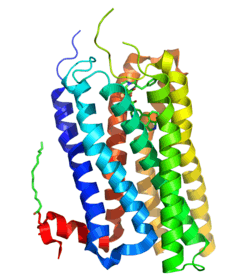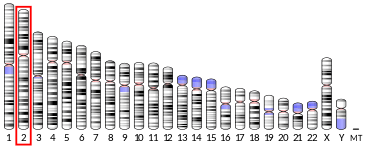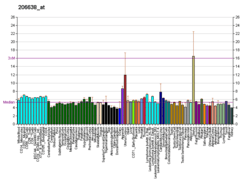5-HT2B receptor
5-Hydroxytryptamine receptor 2B (5-HT2B) also known as serotonin receptor 2B is a protein that in humans is encoded by the HTR2B gene.[5][6] 5-HT2B is a member of the 5-HT2 receptor family that binds the neurotransmitter serotonin (5-hydroxytryptamine, 5-HT).
Tissue distribution and function
The 5-HT2 receptors (of which the 5-HT2B receptor is a subtype) mediate many of the central and peripheral physiologic functions of serotonin. Cardiovascular effects include contraction of blood vessels and shape changes in platelets; central nervous system effects include neuronal sensitization to tactile stimuli and mediation of some of the effects of hallucinogenic substituted amphetamines. The 5-HT2B receptor is highly expressed in the liver and kidney, with lower levels of expression being seen in the cerebral cortex, whole brain, pancreas, and spleen.[7]
The 5-HT2B receptor subtype is involved in:
- CNS: presynaptic inhibition, behavioural effects[8]
- Vascular: pulmonary vasoconstriction[9]
- Cardiac: The 5-HT2B receptor regulates cardiac structure and functions as demonstrated by the abnormal cardiac development observed in 5-HT2B receptor null mice.[10] The 5-HT2B receptor stimulation can also lead to pathological proliferation of cardiac valve fibroblasts,[11] which with chronic overstimulation of 5-HT2B can lead to a severe valvulopathy. Moreover, 5-HT2B receptors were recently shown to be overexpressed in human failing heart and antagonists of 5-HT2B receptors were uncovered to prevent both angiotensin II or beta-adrenergic agonist-induced pathological cardiac hypertrophy in mouse.[12][13][14]
- Serotonin transporter: 5-HT2B receptors regulate serotonin release via the serotonin transporter, and are important both to normal physiological regulation of serotonin levels in blood plasma,[15] and with the abnormal acute serotonin release produced by drugs such as MDMA.[8] Surprisingly however 5-HT2B receptor activation appears to be protective against the development of serotonin syndrome following elevated extracellular serotonin levels,[16] despite its role in modulating serotonin release.
Clinical significance
5-HT2B receptors have also been strongly implicated in drug-induced valvular heart disease.[17][18][19] In this context, it is generally considered to be an antitarget.
The structure of the 5-HT2B receptor was resolved in a complex with the valvulopathogenic drug ergotamine.[20]
Ligands
As of 2009, few highly selective 5-HT2B receptor ligands have been discovered, although numerous potent non-selective compounds are known, particularly agents with concomitant 5-HT2C binding. Research in this area has been limited due to the cardiotoxicity of 5-HT2B agonists, and the lack of clear therapeutic application for 5-HT2B antagonists, but there is still a need for selective ligands for scientific research.[21]
Agonists
- Selective
- BW-723C86:[22] fair functional subtype selectivity; almost full agonist. Anxiolytic in vivo.[23]
- Ro60-0175 [22] functionally selective over 5-HT2A, potent agonist at both 5-HT2B/C
- VER-3323: selective for 5-HT2B/C over 5-HT2A
- α-Methyl-5-HT - moderately selective over 5-HT2A/C
- 6-APB
- LY-266,097 - biased partial agonist in favor of Gq protein, no β-arrestin2 recruitment[24]
- Non-selective
- Guanfacine - an α2A agonist, but has 5-HT2B agonistic activity at therapeutic concentrations.[25]
- MDMA[26]
- MDA[26]
- MEM[27]
- Pergolide[28]
- Cabergoline
- Norfenfluramine[22]
- Chlorphentermine
- Aminorex
- Bromo-dragonfly
- DMT
- 5-MeO-DMT
- LSD - About equal affinity for human cloned 5-HT2B and 5-HT2A receptors.[29]
- psilocin [29]
- Xylometazoline
- Oxymetazoline
- Quinidine
- Ropinirole
- Fenoldopam
- Lorcaserin
- Methylergonovine
- Ergotamine
- Ergonovine
Antagonists
- Agomelatine - primarily a melatonin Mt1/Mt2 receptor agonist, with a less potent antagonism of 5-HT2B and 5-HT2C.[30]
- Amisulpride
- Aripiprazole
- Cariprazine[31]
- Clozapine
- mCPP (in humans)
- Sarpogrelate: a mixed 5-HT2A/B antagonist
- Lisuride: a dopamine agonist of the ergoline class, that is also a 5-HT2B antagonist[32] and a dual 5-HT2A/C agonist[33]
- Tegaserod: primarily a 5-HT4 agonist, but also a 5-HT2B antagonist[34]
- RS-127,445:[35] high affinity; subtype selective (1000x), selective over at least eight other 5-HTR types; orally bioavailable.
- Metadoxine: a 5ht2b antagonist and GABA-activity modulator [36]
- SDZ SER-082: a mixed 5-HT2B/C antagonist
- Promethazine [37]
- EGIS-7625: high selectivity over 5-HT2A[38]
- PRX-08066
- SB-200,646
- SB-204,741
- SB-206,553: mixed 5-HT2B/C antagonist and PAM at α7 nAChR[39]
- SB-215,505 [40]
- SB-228,357
- LY-272,015
Possible applications
5-HT2B antagonists have previously been proposed as treatment for migraine headaches, and RS-127,445 was trialled in humans up to Phase I for this indication, but development was not continued.[41] More recent research has focused on possible application of 5-HT2B antagonists as treatments for chronic heart disease.[42][43] Research claims serotonin 5-HT2B receptors have effect on liver regeneration.[44]
See also
References
- GRCh38: Ensembl release 89: ENSG00000135914 - Ensembl, May 2017
- GRCm38: Ensembl release 89: ENSMUSG00000026228 - Ensembl, May 2017
- "Human PubMed Reference:". National Center for Biotechnology Information, U.S. National Library of Medicine.
- "Mouse PubMed Reference:". National Center for Biotechnology Information, U.S. National Library of Medicine.
- "Entrez Gene: HTR2B 5-hydroxytryptamine (serotonin) receptor 2B".
- Schmuck K, Ullmer C, Engels P, Lübbert H (Mar 1994). "Cloning and functional characterization of the human 5-HT2B serotonin receptor". FEBS Letters. 342 (1): 85–90. doi:10.1016/0014-5793(94)80590-3. PMID 8143856.
- Bonhaus DW, Bach C, DeSouza A, Salazar FH, Matsuoka BD, Zuppan P, Chan HW, Eglen RM (June 1995). "The pharmacology and distribution of human 5-hydroxytryptamine2B (5-HT2B) receptor gene products: comparison with 5-HT2A and 5-HT2C receptors". British Journal of Pharmacology. 115 (4): 622–8. doi:10.1111/j.1476-5381.1995.tb14977.x. PMC 1908489. PMID 7582481.
- Doly S, Valjent E, Setola V, Callebert J, Hervé D, Launay JM, Maroteaux L (Mar 2008). "Serotonin 5-HT2B receptors are required for 3,4-methylenedioxymethamphetamine-induced hyperlocomotion and 5-HT release in vivo and in vitro". The Journal of Neuroscience. 28 (11): 2933–40. doi:10.1523/JNEUROSCI.5723-07.2008. PMC 6670669. PMID 18337424.
- Launay JM, Hervé P, Peoc'h K, Tournois C, Callebert J, Nebigil CG, Etienne N, Drouet L, Humbert M, Simonneau G, Maroteaux L (Oct 2002). "Function of the serotonin 5-hydroxytryptamine 2B receptor in pulmonary hypertension" (PDF). Nature Medicine. 8 (10): 1129–35. doi:10.1038/nm764. PMID 12244304.
- Nebigil CG, Hickel P, Messaddeq N, Vonesch JL, Douchet MP, Monassier L, György K, Matz R, Andriantsitohaina R, Manivet P, Launay JM, Maroteaux L (Jun 2001). "Ablation of serotonin 5-HT(2B) receptors in mice leads to abnormal cardiac structure and function". Circulation. 103 (24): 2973–9. doi:10.1161/01.cir.103.24.2973. PMID 11413089.
- Elangbam CS, Job LE, Zadrozny LM, Barton JC, Yoon LW, Gates LD, Slocum N (Aug 2008). "5-hydroxytryptamine (5HT)-induced valvulopathy: compositional valvular alterations are associated with 5HT2B receptor and 5HT transporter transcript changes in Sprague-Dawley rats". Experimental and Toxicologic Pathology. 60 (4–5): 253–62. doi:10.1016/j.etp.2008.03.005. PMID 18511249.
- Jaffré F, Callebert J, Sarre A, Etienne N, Nebigil CG, Launay JM, Maroteaux L, Monassier L (Aug 2004). "Involvement of the serotonin 5-HT2B receptor in cardiac hypertrophy linked to sympathetic stimulation: control of interleukin-6, interleukin-1beta, and tumor necrosis factor-alpha cytokine production by ventricular fibroblasts". Circulation. 110 (8): 969–74. doi:10.1161/01.CIR.0000139856.20505.57. PMID 15302781.
- Monassier L, Laplante MA, Jaffré F, Bousquet P, Maroteaux L, de Champlain J (Aug 2008). "Serotonin 5-HT(2B) receptor blockade prevents reactive oxygen species-induced cardiac hypertrophy in mice". Hypertension. 52 (2): 301–7. doi:10.1161/HYPERTENSIONAHA.107.105551. PMID 18591460.
- Jaffré F, Bonnin P, Callebert J, Debbabi H, Setola V, Doly S, Monassier L, Mettauer B, Blaxall BC, Launay JM, Maroteaux L (Jan 2009). "Serotonin and angiotensin receptors in cardiac fibroblasts coregulate adrenergic-dependent cardiac hypertrophy". Circulation Research. 104 (1): 113–23. doi:10.1161/CIRCRESAHA.108.180976. PMID 19023134.
- Callebert J, Esteve JM, Hervé P, Peoc'h K, Tournois C, Drouet L, Launay JM, Maroteaux L (May 2006). "Evidence for a control of plasma serotonin levels by 5-hydroxytryptamine(2B) receptors in mice" (PDF). The Journal of Pharmacology and Experimental Therapeutics. 317 (2): 724–31. doi:10.1124/jpet.105.098269. PMID 16461587.
- Diaz SL, Maroteaux L (Sep 2011). "Implication of 5-HT(2B) receptors in the serotonin syndrome". Neuropharmacology. 61 (3): 495–502. doi:10.1016/j.neuropharm.2011.01.025. PMID 21277875.
- Rothman RB, Baumann MH, Savage JE, Rauser L, McBride A, Hufeisen SJ, Roth BL (Dec 2000). "Evidence for possible involvement of 5-HT(2B) receptors in the cardiac valvulopathy associated with fenfluramine and other serotonergic medications". Circulation. 102 (23): 2836–41. doi:10.1161/01.CIR.102.23.2836. PMID 11104741.
- Fitzgerald LW, Burn TC, Brown BS, Patterson JP, Corjay MH, Valentine PA, Sun JH, Link JR, Abbaszade I, Hollis JM, Largent BL, Hartig PR, Hollis GF, Meunier PC, Robichaud AJ, Robertson DW (Jan 2000). "Possible role of valvular serotonin 5-HT(2B) receptors in the cardiopathy associated with fenfluramine". Molecular Pharmacology. 57 (1): 75–81. PMID 10617681.
- Roth BL (Jan 2007). "Drugs and valvular heart disease". The New England Journal of Medicine. 356 (1): 6–9. doi:10.1056/NEJMp068265. PMID 17202450.
- PDB: 4IB4; Wacker D, Wang C, Katritch V, Han GW, Huang XP, Vardy E, McCorvy JD, Jiang Y, Chu M, Siu FY, Liu W, Xu HE, Cherezov V, Roth BL, Stevens RC (May 2013). "Structural features for functional selectivity at serotonin receptors". Science. 340 (6132): 615–9. Bibcode:2013Sci...340..615W. doi:10.1126/science.1232808. PMC 3644390. PMID 23519215.
- Schuhmacher M (2007). [Chiral arylmethoxytryptamines as 5-HT2B-receptor antagonists: synthesis, analysis and in-vitro pharmacology] (German) (PDF) (Thesis). Ph.D. Dissertation. University of Regensburg. pp. 6–17. Retrieved 2008-08-11.
- Porter RH, Benwell KR, Lamb H, Malcolm CS, Allen NH, Revell DF, Adams DR, Sheardown MJ (Sep 1999). "Functional characterization of agonists at recombinant human 5-HT2A, 5-HT2B and 5-HT2C receptors in CHO-K1 cells". British Journal of Pharmacology. 128 (1): 13–20. doi:10.1038/sj.bjp.0702751. PMC 1571597. PMID 10498829.
- Kennett GA, Trail B, Bright F (Dec 1998). "Anxiolytic-like actions of BW 723C86 in the rat Vogel conflict test are 5-HT2B receptor mediated". Neuropharmacology. 37 (12): 1603–10. doi:10.1016/S0028-3908(98)00115-4. PMID 9886683.
- McCorvy JD, Wacker D, Wang S, Agegnehu B, Liu J, Lansu K, et al. (August 2018). "Structural determinants of 5-HT2B receptor activation and biased agonism". Nature Structural & Molecular Biology. 25 (9): 787–796. doi:10.1038/s41594-018-0116-7. PMC 6237183. PMID 30127358.
- Huang XP, Setola V, Yadav PN, Allen JA, Rogan SC, Hanson BJ, Revankar C, Robers M, Doucette C, Roth BL (Oct 2009). "Parallel functional activity profiling reveals valvulopathogens are potent 5-hydroxytryptamine(2B) receptor agonists: implications for drug safety assessment". Molecular Pharmacology. 76 (4): 710–22. doi:10.1124/mol.109.058057. PMC 2769050. PMID 19570945.
- Setola V, Hufeisen SJ, Grande-Allen KJ, Vesely I, Glennon RA, Blough B, Rothman RB, Roth BL (Jun 2003). "3,4-methylenedioxymethamphetamine (MDMA, "Ecstasy") induces fenfluramine-like proliferative actions on human cardiac valvular interstitial cells in vitro". Molecular Pharmacology. 63 (6): 1223–1229. doi:10.1124/mol.63.6.1223. PMID 12761331.
- Ray TS (2010). Manzoni OJ (ed.). "Psychedelics and the human receptorome". PLOS ONE. 5 (2): e9019. Bibcode:2010PLoSO...5.9019R. doi:10.1371/journal.pone.0009019. PMC 2814854. PMID 20126400.
- Görnemann T, Hübner H, Gmeiner P, Horowski R, Latté KP, Flieger M, Pertz HH (Mar 2008). "Characterization of the molecular fragment that is responsible for agonism of pergolide at serotonin 5-Hydroxytryptamine2B and 5-Hydroxytryptamine2A receptors". The Journal of Pharmacology and Experimental Therapeutics. 324 (3): 1136–45. doi:10.1124/jpet.107.133165. PMID 18096760.
- "PDSP Ki database, University of North Carolina at Chapel Hill". Retrieved 2019-09-04.
- Millan MJ, Gobert A, Lejeune F, Dekeyne A, Newman-Tancredi A, Pasteau V, Rivet JM, Cussac D (Sep 2003). "The novel melatonin agonist agomelatine (S20098) is an antagonist at 5-hydroxytryptamine2C receptors, blockade of which enhances the activity of frontocortical dopaminergic and adrenergic pathways". The Journal of Pharmacology and Experimental Therapeutics. 306 (3): 954–64. doi:10.1124/jpet.103.051797. PMID 12750432.
- Garnock-Jones, Karly P. (June 2017). "Cariprazine: A Review in Schizophrenia". CNS Drugs. 31 (6): 513–525. doi:10.1007/s40263-017-0442-z. ISSN 1179-1934. PMID 28560619.
- Hofmann C, Penner U, Dorow R, Pertz HH, Jähnichen S, Horowski R, Latté KP, Palla D, Schurad B (2006). "Lisuride, a dopamine receptor agonist with 5-HT2B receptor antagonist properties: absence of cardiac valvulopathy adverse drug reaction reports supports the concept of a crucial role for 5-HT2B receptor agonism in cardiac valvular fibrosis". Clinical Neuropharmacology. 29 (2): 80–6. doi:10.1097/00002826-200603000-00005. PMID 16614540.
- Egan CT, Herrick-Davis K, Miller K, Glennon RA, Teitler M (Apr 1998). "Agonist activity of LSD and lisuride at cloned 5HT2A and 5HT2C receptors". Psychopharmacology. 136 (4): 409–14. doi:10.1007/s002130050585. PMID 9600588.
- Beattie DT, Smith JA, Marquess D, Vickery RG, Armstrong SR, Pulido-Rios T, McCullough JL, Sandlund C, Richardson C, Mai N, Humphrey PP (Nov 2004). "The 5-HT4 receptor agonist, tegaserod, is a potent 5-HT2B receptor antagonist in vitro and in vivo". British Journal of Pharmacology. 143 (5): 549–60. doi:10.1038/sj.bjp.0705929. PMC 1575425. PMID 15466450.
- Bonhaus DW, Flippin LA, Greenhouse RJ, Jaime S, Rocha C, Dawson M, Van Natta K, Chang LK, Pulido-Rios T, Webber A, Leung E, Eglen RM, Martin GR (Jul 1999). "RS-127445: a selective, high affinity, orally bioavailable 5-HT2B receptor antagonist". British Journal of Pharmacology. 127 (5): 1075–82. doi:10.1038/sj.bjp.0702632. PMC 1566110. PMID 10455251.
- "Metadoxine extended release (MDX) for adult ADHD". Alcobra Ltd. 2014. Retrieved 2014-05-07.
- "promethazine | Activity data visualisation tool | IUPHAR/BPS Guide to PHARMACOLOGY". www.guidetopharmacology.org. Retrieved 2019-02-28.
- Kovács A, Gacsályi I, Wellmann J, Schmidt E, Szücs Z, Dubreuil V, Nicolas JP, Boutin J, Bózsing D, Egyed A, Tihanyi K, Spedding M, Szénási G (2003). "Effects of EGIS-7625, a selective and competitive 5-HT2B receptor antagonist". Cardiovascular Drugs and Therapy. 17 (5–6): 427–34. doi:10.1023/B:CARD.0000015857.96371.43. PMID 15107597.
- Dunlop J, Lock T, Jow B, Sitzia F, Grauer S, Jow F, Kramer A, Bowlby MR, Randall A, Kowal D, Gilbert A, Comery TA, Larocque J, Soloveva V, Brown J, Roncarati R (Mar 2009). "Old and new pharmacology: positive allosteric modulation of the alpha7 nicotinic acetylcholine receptor by the 5-hydroxytryptamine(2B/C) receptor antagonist SB-206553 (3,5-dihydro-5-methyl-N-3-pyridinylbenzo[1,2-b:4,5-b']di pyrrole-1(2H)-carboxamide)". The Journal of Pharmacology and Experimental Therapeutics. 328 (3): 766–76. doi:10.1124/jpet.108.146514. PMID 19050173.
- Reavill C, Kettle A, Holland V, Riley G, Blackburn TP (Feb 1999). "Attenuation of haloperidol-induced catalepsy by a 5-HT2C receptor antagonist". British Journal of Pharmacology. 126 (3): 572–4. doi:10.1038/sj.bjp.0702350. PMC 1565856. PMID 10188965.
- Poissonnet G, Parmentier JG, Boutin JA, Goldstein S (Mar 2004). "The emergence of selective 5-HT 2B antagonists structures, activities and potential therapeutic applications". Mini Reviews in Medicinal Chemistry. 4 (3): 325–30. doi:10.2174/1389557043487312. PMID 15032678.
- Shyu KG (Jan 2009). "Serotonin 5-HT2B receptor in cardiac fibroblast contributes to cardiac hypertrophy: a new therapeutic target for heart failure?". Circulation Research. 104 (1): 1–3. doi:10.1161/CIRCRESAHA.108.191122. PMID 19118279.
- Moss N, Choi Y, Cogan D, Flegg A, Kahrs A, Loke P, Meyn O, Nagaraja R, Napier S, Parker A, Thomas Peterson J, Ramsden P, Sarko C, Skow D, Tomlinson J, Tye H, Whitaker M (Apr 2009). "A new class of 5-HT2B antagonists possesses favorable potency, selectivity, and rat pharmacokinetic properties". Bioorganic & Medicinal Chemistry Letters. 19 (8): 2206–10. doi:10.1016/j.bmcl.2009.02.126. PMID 19307114.
- Ebrahimkhani MR, Oakley F, Murphy LB, Mann J, Moles A, Perugorria MJ, Ellis E, Lakey AF, Burt AD, Douglass A, Wright MC, White SA, Jaffré F, Maroteaux L, Mann DA (Dec 2011). "Stimulating healthy tissue regeneration by targeting the 5-HT₂B receptor in chronic liver disease". Nature Medicine. 17 (12): 1668–73. doi:10.1038/nm.2490. PMC 3428919. PMID 22120177.
Further reading
- Raymond JR, Mukhin YV, Gelasco A, Turner J, Collinsworth G, Gettys TW, Grewal JS, Garnovskaya MN (2002). "Multiplicity of mechanisms of serotonin receptor signal transduction". Pharmacology & Therapeutics. 92 (2–3): 179–212. doi:10.1016/S0163-7258(01)00169-3. PMID 11916537.
- Choi DS, Birraux G, Launay JM, Maroteaux L (Oct 1994). "The human serotonin 5-HT2B receptor: pharmacological link between 5-HT2 and 5-HT1D receptors". FEBS Letters. 352 (3): 393–9. doi:10.1016/0014-5793(94)00968-6. PMID 7926008.
- Kursar JD, Nelson DL, Wainscott DB, Baez M (Aug 1994). "Molecular cloning, functional expression, and mRNA tissue distribution of the human 5-hydroxytryptamine2B receptor". Molecular Pharmacology. 46 (2): 227–34. PMID 8078486.
- Schmuck K, Ullmer C, Engels P, Lübbert H (Mar 1994). "Cloning and functional characterization of the human 5-HT2B serotonin receptor". FEBS Letters. 342 (1): 85–90. doi:10.1016/0014-5793(94)80590-3. PMID 8143856.
- Launay JM, Birraux G, Bondoux D, Callebert J, Choi DS, Loric S, Maroteaux L (Feb 1996). "Ras involvement in signal transduction by the serotonin 5-HT2B receptor". The Journal of Biological Chemistry. 271 (6): 3141–7. doi:10.1074/jbc.271.6.3141. PMID 8621713.
- Le Coniat M, Choi DS, Maroteaux L, Launay JM, Berger R (Feb 1996). "The 5-HT2B receptor gene maps to 2q36.3-2q37.1". Genomics. 32 (1): 172–3. doi:10.1006/geno.1996.0101. PMID 8786115.
- Kim SJ, Veenstra-VanderWeele J, Hanna GL, Gonen D, Leventhal BL, Cook EH (Feb 2000). "Mutation screening of human 5-HT(2B)receptor gene in early-onset obsessive-compulsive disorder". Molecular and Cellular Probes. 14 (1): 47–52. doi:10.1006/mcpr.1999.0281. PMID 10722792.
- Manivet P, Mouillet-Richard S, Callebert J, Nebigil CG, Maroteaux L, Hosoda S, Kellermann O, Launay JM (Mar 2000). "PDZ-dependent activation of nitric-oxide synthases by the serotonin 2B receptor". The Journal of Biological Chemistry. 275 (13): 9324–31. doi:10.1074/jbc.275.13.9324. PMID 10734074.
- Becamel C, Figge A, Poliak S, Dumuis A, Peles E, Bockaert J, Lubbert H, Ullmer C (Apr 2001). "Interaction of serotonin 5-hydroxytryptamine type 2C receptors with PDZ10 of the multi-PDZ domain protein MUPP1". The Journal of Biological Chemistry. 276 (16): 12974–82. doi:10.1074/jbc.M008089200. PMID 11150294.
- Manivet P, Schneider B, Smith JC, Choi DS, Maroteaux L, Kellermann O, Launay JM (May 2002). "The serotonin binding site of human and murine 5-HT2B receptors: molecular modeling and site-directed mutagenesis". The Journal of Biological Chemistry. 277 (19): 17170–8. doi:10.1074/jbc.M200195200. PMID 11859080.
- Borman RA, Tilford NS, Harmer DW, Day N, Ellis ES, Sheldrick RL, Carey J, Coleman RA, Baxter GS (Mar 2002). "5-HT(2B) receptors play a key role in mediating the excitatory effects of 5-HT in human colon in vitro". British Journal of Pharmacology. 135 (5): 1144–51. doi:10.1038/sj.bjp.0704571. PMC 1573235. PMID 11877320.
- Matsuda A, Suzuki Y, Honda G, Muramatsu S, Matsuzaki O, Nagano Y, Doi T, Shimotohno K, Harada T, Nishida E, Hayashi H, Sugano S (May 2003). "Large-scale identification and characterization of human genes that activate NF-kappaB and MAPK signaling pathways". Oncogene. 22 (21): 3307–18. doi:10.1038/sj.onc.1206406. PMID 12761501.
- Slominski A, Pisarchik A, Zbytek B, Tobin DJ, Kauser S, Wortsman J (Jul 2003). "Functional activity of serotoninergic and melatoninergic systems expressed in the skin". Journal of Cellular Physiology. 196 (1): 144–53. doi:10.1002/jcp.10287. PMID 12767050.
- Lin Z, Walther D, Yu XY, Drgon T, Uhl GR (Dec 2004). "The human serotonin receptor 2B: coding region polymorphisms and association with vulnerability to illegal drug abuse". Pharmacogenetics. 14 (12): 805–11. doi:10.1097/00008571-200412000-00003. PMID 15608559.
External links
- "5-HT2B". IUPHAR Database of Receptors and Ion Channels. International Union of Basic and Clinical Pharmacology.
- Human HTR2B genome location and HTR2B gene details page in the UCSC Genome Browser.
- Overview of all the structural information available in the PDB for UniProt: P41595 (5-hydroxytryptamine receptor 2B) at the PDBe-KB.
This article incorporates text from the United States National Library of Medicine, which is in the public domain.





